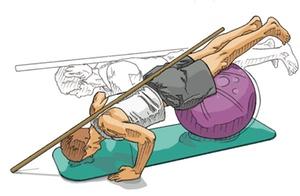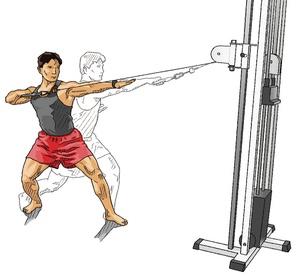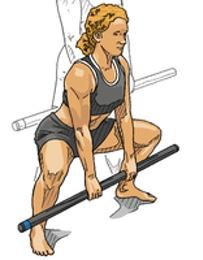Primal Pattern Movements: Swiss Ball Push-Up
by Paul Chek

In this series, I’ve been giving you a tour of the Primal Pattern® movement patterns, the seven most important movements for optimal human functioning.
- Pull
- Twist
- Gait (walking, jogging, running)
- Squat
- Bend
- Lunge
- Push
So far we’ve looked at the Twist and Pull patterns. For week three of this series, we’ll look at the Push pattern.
One important note before we look at a push exercise.
A functional core — which should naturally result from our infant developmental stages — is crucial for a functional push, as this provides a firm foundation for the arm and shoulder musculature to work from, and also anchors the pelvis and lower extremities. Dysfunction in the core often leads to over-work in the shoulder joint – as is so common in professional pitchers and bowlers who may undergo repeated surgery for rotator cuff injuries and similar.
With that in mind, here’s a simple but effective Push Pattern exercise for you to incorporate: The Swiss Ball Push-Up.
 Swiss Ball Push-Up
Swiss Ball Push-Up
Starting Position: Roll out over a Swiss ball into the plank position, with your feet or shins on the ball. (The farther the ball is from your torso, the harder the exercise will be.) Place your hands so that they are at the level of your shoulders and a comfortable width apart.
Action: Keeping your spine and head in alignment (do not let your head drop forward or your lower back sag down or hunch up), lower your chest toward the ground. Push back to the start position, maintaining perfect form.
Suggested reps: 8-20.
Make it easier: Place the ball under your hips.
Make it harder: Place the ball under your feet or lift one foot off the ball.
Purpose: A Swiss ball push-up adds extra work for the abdominal and core muscles, as well as the upper body pushing muscles.
Some tips to remember about starting any new exercise program:
- Talk to your health care provider before beginning a new training program.
- Perform each exercise with a moderate tempo.
- Suggested repetitions for each exercise are listed, but it is more important to follow the Form Principle. Only select the level of exercise that can be performed with the perfect technique and stop each set before your form breaks down.
Love and chi,
Paul


